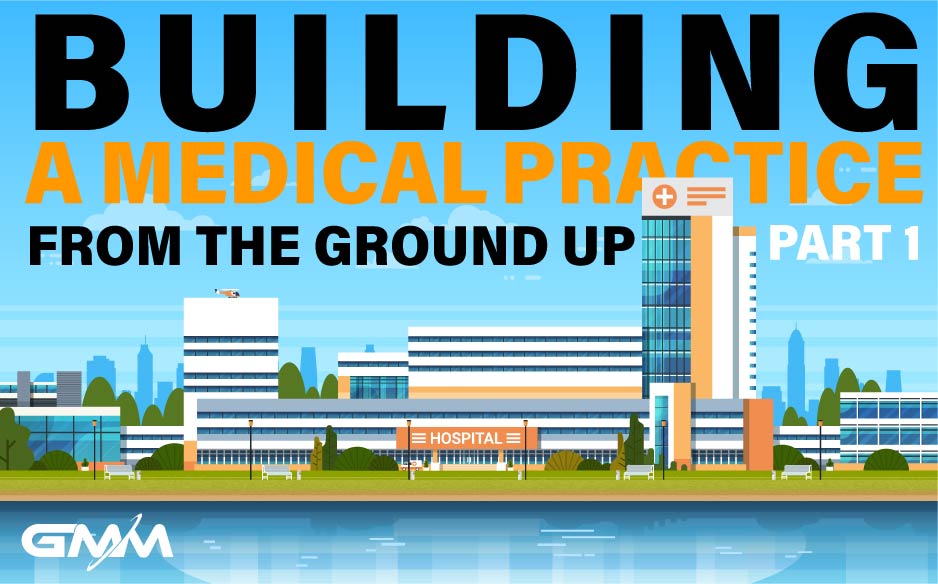Beginning a medical practice is a challenging but exciting time for any physician. Just like your step-by-step plan for obtaining your medical degree and gaining your experience, building a private medical practice will take a well thought out and detailed plan. There are many things to consider and steps to take when building your practice, we will briefly explore each step in this two-part series of “Building a Medical Practice from the Ground Up.”
Steps to Begin a Medical Practice
- Type of Practice
- Financing
- Legal Compliance
- Facility and Furnishings
- Staffing
- Equipment
- Marketing and Opening
- Professional Consultant
Type of Practice
The first step is deciding which type of practice you want to build: solo, group, or as part of a larger hospital-owned network. You could take full responsibility with a solo practice, but with that control comes the extensive start-up costs and financial responsibilities. With a group practice, you could share some of those responsibilities, including sharing the workload. Working with a larger network provides you with capital and someone to help with legal and financial risks, but reduces your independent flexibility, as you will answer to a medical board.
You may know exactly what you want to do, or you may want to work with an experienced professional consultant. A professional consultant understands all the legal and financial challenges, will provide you with a clear understanding of all variables, will help you develop a productive plan, and help you avoid making costly and time-consuming mistakes. Depending on your specialty, you may want to consider whether there are any ancillary services you want to provide to make your practice stand out from others.
Legal Compliance
There are several legal compliance steps you must take to establish a medical practice. Incorporating as a legal entity and obtaining a tax ID is your first step to protect your personal assets. Determine which type of entity to incorporate as (LLC, S-Corp, or C-Corp) to obtain the most benefits for your practice. Purchase medical and malpractice insurance to protect your practice, as well as general liability insurance and worker’s compensation.
All healthcare providers in your practice will need to be credentialed with the various insurance entities who will be paying your claims. Credentialing with the variety of payers can be a lengthy and intensive process so begin this as soon as possible.
Develop written policies and procedures regarding your daily operations, such as data entry, billing, and all communications and interactions with patients and patient data. Be sure to keep all legal regulations and compliance requirements in mind.
Financing
The first step for financing will be to develop a business plan for the first five years. You will want to ensure you are realistic about your revenue and debt projections, with back up data confirming facility costs, equipment expenses, staff expenses, and all operational expenses. From that business plan you will develop a pro forma financial statement to provide to potential investors. Your simplified budget statement will outline the inflow of projected revenues and the outflow of funds for the next 3 to 5 years, including the start-up costs.
When approaching banks, be sure to reach out to their medical/dental divisions so you are working with someone who understands the expense and revenue models of medical practices. Approach at least 5 to 10 different banks and review your different offers carefully for terms that fit your needs.
Facility and Furnishings
Finding the right facility to fit your needs is an important decision. It may be a previous medical facility with many of the furnishings you already need, or it may be a facility requiring modifications and the services of a contractor. Be sure to allow plenty of time for construction needs before planning your opening. Examine leases carefully before signing, and don’t forget to obtain facility insurance.
When it comes to furnishings, realize that you can keep costs low, initially, until you have developed your practice and can afford to upgrade those furnishings. The only thing your patients will want is comfortable waiting areas and examination rooms that appear clean and well-kept. Staff will want adequate desks, chairs, and storage spaces for files and supplies.
Don’t miss part 2 of “Building a Medical Practice from the Ground Up” coming soon. Genesis Medical Management helps medical organizations to thrive in this highly competitive industry. Contact us today to help you with operational management, growth strategies, revenue cycle, and real estate development.
Let's Grow Together!
We look forward to learning about your healthcare business to discover how GMM can create a profitable solution!

